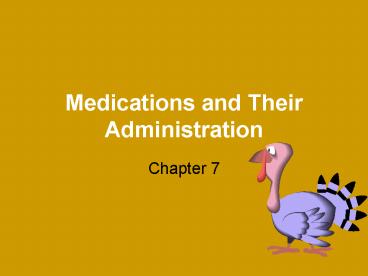Medications and Their Administration - PowerPoint PPT Presentation
1 / 10
Title:
Medications and Their Administration
Description:
Pharmacokinetics: how drugs enter the body, are absorbed, reach their site of ... Enteral route: oral, sublingual, rectal, oral and NG tube (example of sublingual ... – PowerPoint PPT presentation
Number of Views:96
Avg rating:3.0/5.0
Title: Medications and Their Administration
1
Medications and Their Administration
- Chapter 7
2
Medical Nomenclature
- Generic name identifies the chemical family
- Trade name given to a drug by a manufacturer
- PDR physicians desk reference reference book
that lists drugs alphabetically, by trade name
and according to their uses
3
Medication Properties
- Pharmacokinetics how drugs enter the body, are
absorbed, reach their site of action and are
metabolized physiologic action of medication - Absorption process by which a drug enters the
systemic circulation in order to provide a
desired effect - Distribution means by which a drug travels from
site of absorption to site of action - Excretion elimination of drugs from the body
after they have been metabolized - Toxicity effect that can occur when there is
impaired kidney function, dehydration or
insufficient fluid intake drugs are retained in
the body and can build up common in elderly
Drug that treats toxic effects is an antidote. - Pharmacodynamics study of the effects of drugs
on normal physiological functions of the body
4
Medication Effects
- Idiosyncratic reaction patient underreacts or
overreacts to a drug or has an unusual reaction. - Allergic reaction occurs when a patient has
been sensitized to the initial dose and develops
an allergic response to the allergen and related
drugs - Synergistic effect when certain drugs are taken
together and produce effects far beyond the
desired outcome
5
Common Medications
- Medications for allergic reactions
diphenhydramine (Benadryl), epinephrine
(Adrenalin), methylprednisone (Solu-medrol)
Solu-medrol minimizes the possibility of
respiratory arrest by reducing swelling of the
bronchial tree - Antimicrobials alcohol and betadine,
antibiotics - Anticonvulsants prescribed for patients with
chronic seizure disorders (diazepam- valium this
will be found on the crash cart) - Antiarrhythmics used to treat chronic cardiac
arrythmias (lidocaine) - Analgesics pain relievers with no loss of
consicousness (demerol and morphine) CNS
depression - Controlled substance drugs with high potential
for abuse - Sedatives and tranquilizers sleep inducing
anxiety reduction valium and versed are common
sedatives in the radiology department can also
cause respiratory depression
6
More Meds
- Antagonist drug that counteracts the effects of
sedatives and analgesics (Flumazenil and Narcan) - Local Anesthetic lidocaine (xyolocaine)
constricts the blood vessels in a localized area - Succinylcholine chloride given as a skeletal
muscular relaxant for purposes like the insertion
of ET tubes all muscles are temporarily
paralyzed. Used on patients who are combative
from fear, shock, intoxication. - Anticholinergenics drugs given to suppress
secretions before and during surgery
7
The 5 Rights of Medication Administration
- Right dose
- Right medication
- Right patient
- Right time
- Right route
- Read all labels 3 times before administration
check the expiration date.
8
Routes of Administration
- Enteral route oral, sublingual, rectal, oral
and NG tube (example of sublingual is
nitroglycerin under the tongue for angina
pectoris) - Parenteral medications are injected directly
into the body intradermal, subcutaneous,
intramuscular, intravenously (most rapid effect
from administration)
9
Injection Buzz Words
- Ampule
- Vial
- Butterfly set
- Iv catheters
- Intermittent injection port (heparin or saline
lock) - Extravasation or infiltration
- Hydrostatic pressure
- Infusion
10
IV Starting Facts
- After injecting meds into a port, it needs to be
flushed with saline or heparin - Some common sites for IV placement include
median cubital vein and the basilic - The proper height for IV bag or bottle is 18-20
inches above the vein - Once a needle is removed from the vein, hold
pressure or a hematoma may result - If extravasation occurs, remove the needle and
apply cold compress































